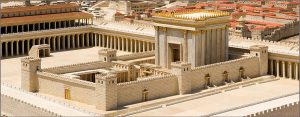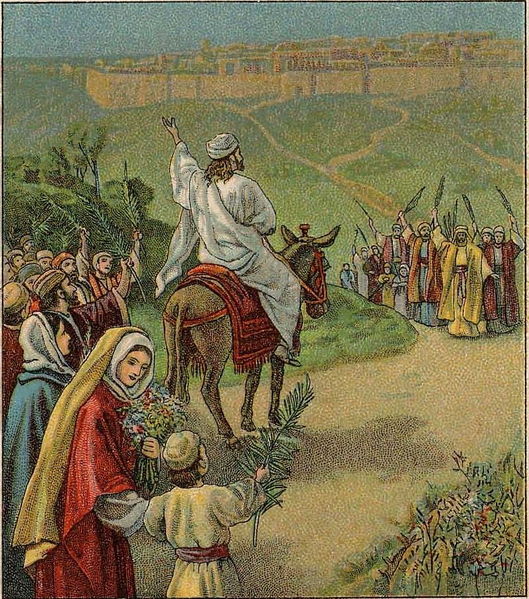Exodus 23:14–19, Three times you shall keep a feast. The Scriptures teach us that during the three biblical pilgrimage festivals of Passover/Unleavened Bread, Pentecost and Tabernacles all Israelites were to leave their places of individual isolation and were to go up to where the presence of Elohim of Israel was. This sacred rendezvous was to occur according to the festival cycle or circle (Heb. chag) around the common sanctuary (where YHVH had chosen to place his name, Deut 16:2, 11, 15).
In fulfilling this command,each Israelite would become conscious in a real way that he was connected to all the other members of the nation of Israel, with YHVH Elohim, and with the Torah (The Pentateuch—Deuteronomy, p. 310, by S. R. Hirsch).
In biblical times, the Israelites would gather wherever the tabernacle had been placed. When the temple was built in Jerusalem, this city became the destination point for the Israelite pilgrims during these three biblical feasts.
For the saints who celebrate the biblical feasts now, there is no temple in Jerusalem to gather around. The saints are now the spiritual temple of the Spirit of Elohim (1 Cor 3:16). Moreover, Yeshua has promised to be in the midst of his people when they gather together (Matt 18:20). In light of these spiritual realities, YHVH’s people need to pray and seek his face to find out where he wants them to gather for his feasts, and then obey him in faith believing that he will be with them.
But there is much more to this spiritual dynamic if we add Yeshua the Messiah of Israel into the picture. This is because each of the three feasts point directly to him. Passover and the Feast of Unleavened Bread, the Feast of Weeks or Pentecost, and the Feast of Tabernacles all point to Yeshua, since the first two festal periods point to Yeshua’s first coming, while the last fall feast points to his second coming. Each of these feasts represent milestones in the spiritual journey of the redeemed believer from initial redemption to glorification and eternal life in the presence of YHVH Elohim.
The three feasts also spiritually represent the three sections in the Tabernacle of Moses (Heb. mishkan). These are the outer courtyard, the holy place and the holy of holies. These three sections of the tabernacle correspond with the three parts of man, which are his body, soul and spirit (1 Thess 5:23). The feasts of Passover (Heb. Pesach) and Unleavened Bread (Heb. Chag haMatzot) are the first two feasts the righteous believers are to celebrate in the spring and represent the first steps in a new believer’s spiritual walk. This corresponds with the outer courtyard and relates more to the spiritual cleansing of the outer parts or body of man. It is here that one begins their spiritual walk and relationship with Yeshua, who is the Word of Elohim. The Feast of Weeks or Pentecost (Heb. Shavuot) is the next step one takes in their spiritual walk as one goes into the tabernacle of Moses. The tabernacle’s holy place speaks of one bringing one’s soul (the mind, will and emotions) into submission to the will of YHVH as one advances in their spiritual walk and grows in the fruits and gifts of the Spirit of Elohim. This readies the redeemed Israelites to move into a place of worship and praise before the Almighty.
Finally, the holy of holies corresponds to the Feast of Tabernacles (Heb. Chag haSukkot) and the spirit part of man. This section of the tabernacle points to man’s ultimate spiritual relationship with Elohim. It is here that man relates to Elohim, who is a Spirit, on a deeper spirit to Spirit level (John 4:24; 1 Cor 2:10–13). This prophetically points to man’s ultimate destiny as glorified beings in the New Jerusalem as adopted members into the family of Elohim (John 1:12; Rom 8:14–15, 23; 9:4; 2 Cor 6:18; Gal 4:5–6; Eph 1:5; 1 John 3:1; Rev 21:7).
Three times in the year. Three times a year at the three pilgrimage feasts—the Feast of Unleavened Bread, Feast of Weeks (Pentecost) and Feast of Tabernacles—Elohim commands that all men appear before him at the place where he has chosen to place his name (Deut 16:2, 6, 11, 15, 16). At these three times, Israelites would gather wherever the tabernacle or temple of Elohim was located to celebrate before Elohim with their fellow Israelites. The Torah repeats this command in Deuteronomy 16:6–17. 
On these three occasions, YHVH commands that all males bring with them a feast offering—they were not to appear before YHVH empty-handed, but they were to bring an offering as they were able according to how YHVH had blessed them materially during the year (Deut 16:16). This was not a tithe, but a freewill love offering in addition to their regular tithes. Through Malachi the prophet, YHVH accuses backslid Israel of robbing him by not giving to him their tithes and offerings (or contributions). Because of this negligence, Elohim declares that Israel has been cursed with a curse,whereupon he promises to reverse the curse, rebuke the devourer that has destroyed their prosperity, to open the windows of heaven over them so that the will not be able to contain the prosperity of YHVH (Mal 3:8–12).
Some people may insist that this offering no longer applies to those who are “under the new covenant.” However, Yeshua declares that not one jot or tittle of the Torah has been annulled (Matt 5:18), and those who follow the eternal principles of the Torah will be blessed (Matt 5:19). Although, we may not be able now to fulfill all aspects of YHVH feast laws, YHVH expects us to love him and to keep all of his commandments the best we can (John 14:14; 1 John 2:3–6). To not obey his Torah-commands is sin (1 John 3:4), and on judgment day, Yeshua promises to reject those who were Torahless (workers of iniquity), despite their professed religiosity (Matt 7:21–23).
Giving financially to those who are doing the ministry of Yeshua is a spiritual principle that is immutable, universal and is part of the walk of the righteous redeemed (Prov 3:9–10; Phil 4:14–17; 1 Tim 5:17–18; 1 Cor 9:13–14; Gal 6:6).



How can we not love God who gives us beauty for ashes even! How beautiful is His word? (that’s really not a question but rather a quest!)
As a side note-thinking about Mt Sinai (just watched a video of Ryan Mauro’s on SinaiInArabia.com) where it mentions Elim, my research gives no clear definition of Elim, now I know it’s the place where the 70 palm trees and the 12 wells are but just in looking at the word El=God and “IM” plural and they said “these be your gods O Israel” could not that be the meaning of Elim? What light can you shed on this for me Natan, please.
Back in 2014,I did a video on the meaning of Elim, which you can view at
.
Also, here are my notes on Elim:
Exodus 15:27, Elim. The name of this oasis in the wilderness where the Israelites found refreshment is rich in meaning and prophetic significance. Elim is the plural of ayil meaning “porch, vestibule or hall” and probably refers to the large and imposing porch that existed in front of the main entrances of some ancient middle eastern temples including that of Solomon’s Temple. These porches were often supported by two large pillars. In the case of Solomon’s Temple, these two pillars were named Yachin [meaning “he will establish”] and Boaz [possibly meaning “fleetness” or “established in strength”]. Elsewhere ayil can refer to temple pillars (e.g. Ezekiel’s temple, Ezek 40–41), which sometimes featured palm tree ornamentation (Ezek 40:31). Ayil can also mean “mighty leader, ram, or a terebinth tree, which grows in the Middle East and was likely the Pistacia terebinthus (or turpentine tree) or perhaps the Pistacia palaestina. This short (30 feet mature height), stout, thick-trunked tree is sometimes translated in the Bible as oak, which is a different species of tree altogether and is not related to the pistacia or terebinth tree. As we can see from this brief word study, elim is rich in meaning, and primarily refers to something which envisions strength (e.g. ram, a stout tree), and which supports something else (like a pillar that supports a building).
The word Elim and the oasis by this name is rich in spiritual significance with its 70 palm trees and 12 wells of water. Seventy is the number of nations listed in Genesis chapter ten, and the number of Israelites YHVH sent to live in Egypt with Jacob to evangelize that nation (Exod 1:5). Seventy is also the number of the elders that Moses chose to help him lead Israel (Exod 24:1; Num 11:16), and which eventually became the Jewish Sanhedrin (a.k.a as “the Great Assembly”), which, under the Romans, ruled Israel in the time of Yeshua. Our Lord himself, chose 70 disciples to evangelize Judea (Luke 10:1,17), who later became the founders and leaders of the apostolic church or kehilah. It was these same seventy evangelists along with the twelve disciples who Yeshua commissioned to go to the descendents of those patriarchs of the seventy nations listed in Genesis chapter ten.
The twelve wells of water at oasis Elim may signify the twelve tribes of Israel and latter the twelve apostles, which YHVH commissioned to take the water (and the light and truth) of his Torah-word to the nations (Deut 4:6; Matt 28:19; Acts 1:8). Water is a biblical metaphor for Torah or the word of Elohim (Deut 32:2; Eph 5:26), and Isaiah likens the message of the gospel or salvation to water from a well (Isa 12:3).
Israel’s arriving at Elim, therefore, could be viewed as a prophetic vision of their future YHVH-ordained spiritual destiny as the people through whom YHVH would bring the fresh water of his Torah-word (including the good news of the Messiah, who was the Living Torah-word of Elohim incarnate) to a world dying of thirst and starvation in the midsts of the bleak wilderness of life called human existence. As such, YHVH expected his people to stand firm like pillars or trees, and resolutely strong like a ram in the face of great adversity and resistance as they fulfilled their divine commission to evangelize the world. Those who fulfilled this mission, YHVH promised, as their reward for faithful duty, to make pillars in the spiritual and eternal temple of the soon-coming New Jerusalem (Rev 3:12).
Wow, wow, wow! Thank you for the elucidation! I love it and you explained it so beautifully. thanks again 🙂